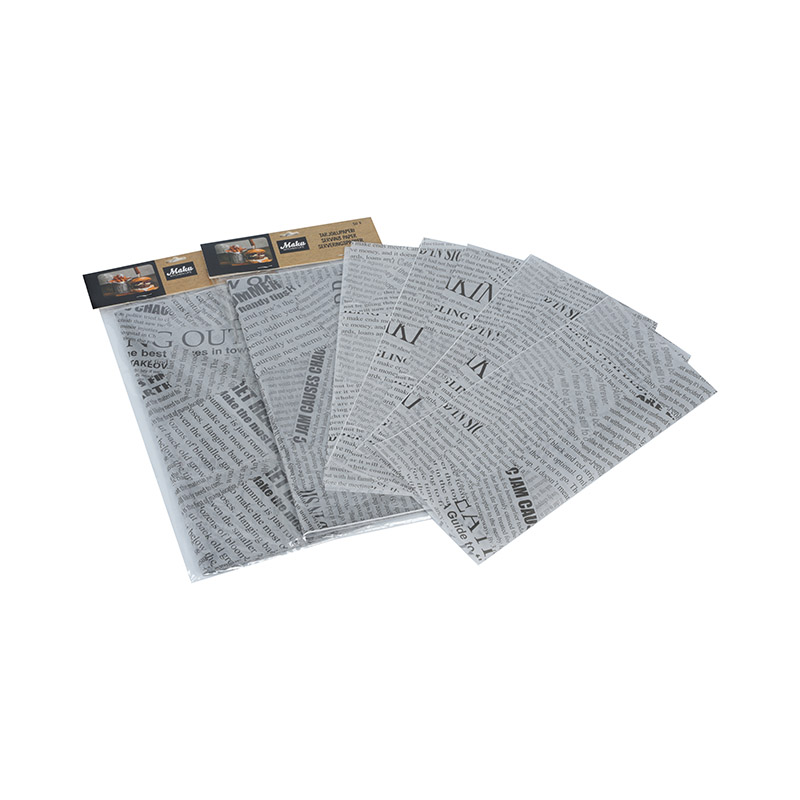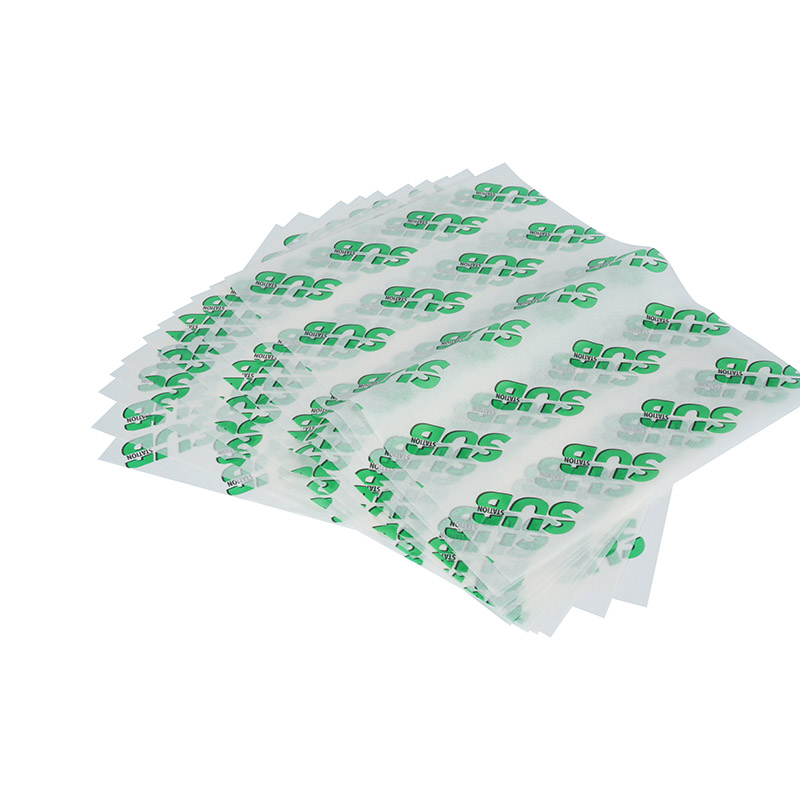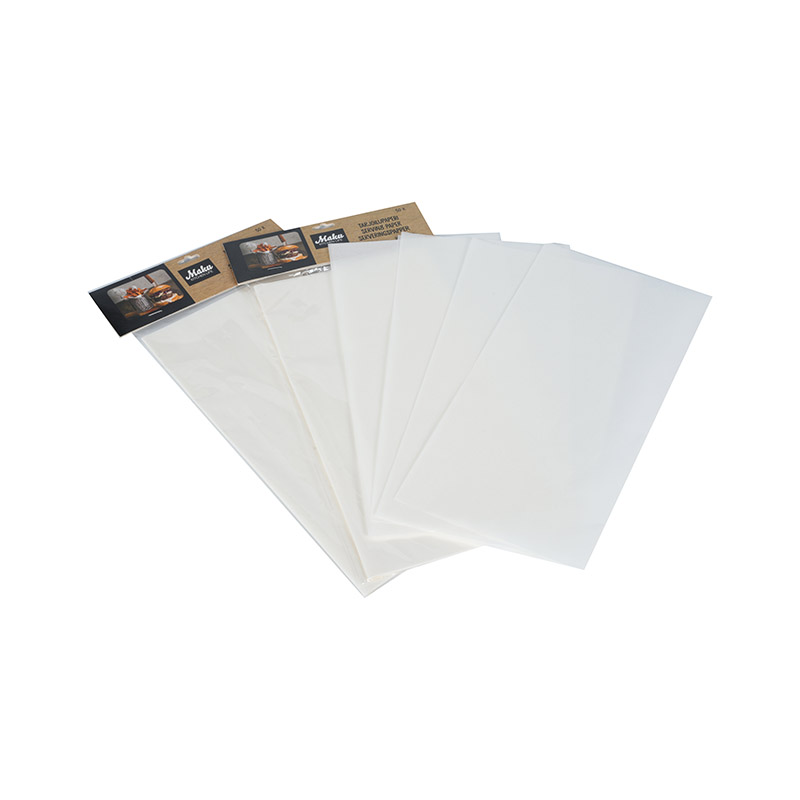The Packaging Conundrum: Necessity Meets Responsibility In the fast-paced world of grab-and-go meals, packaging is an unavoidable necessity. It protec...
READ MOREAll
Baking Paper
Greaseproof Paper
Wax Paper
Parchment Paper
Cooking Sheet Paper
Steaming Paper
Hamburger Wrap
Sandwich Wrap
Pan Liner
Candy Wrap
Air Fryer Paper

Compatible Printing Inkjet Printing Printing Handling Flexographic Printing Usage Food Packaging Cer...

Compatible Printing Inkjet Printing Printing Handling Flexographic Printing Usage Food Packaging Cer...

Compatible Printing Inkjet Printing Printing Handling Flexographic Printing Usage Food Packaging Cer...
The Packaging Conundrum: Necessity Meets Responsibility In the fast-paced world of grab-and-go meals, packaging is an unavoidable necessity. It protec...
READ MOREHave you ever stopped to appreciate the simple sheet of paper that separates your juicy burger from your hands? It might seem trivial, but hamburger w...
READ MOREIn the fast-paced, high-stakes environment of a professional kitchen, every supply choice matters. From the quality of the ingredients to the efficien...
READ MOREIn the realm of professional and home kitchens alike, certain tools rise to the level of indispensable. Among these foundational items are parchment p...
READ MOREHow the oil-proof coating on hamburger wrap is oil-proof or durable?
In the fast-paced world of fast food, hamburger wraps play a crucial role in maintaining food quality and presentation. These wraps must be able to withstand oil and grease while remaining durable enough to protect the food during transportation and handling. Achieving these properties involves the application of specialized oil-proof coatings. This article explores the science behind these coatings, examining how they work to provide oil resistance and durability, and the shift towards more environmentally responsible alternatives.
Understanding Oil-Proof Coatings
Oil-proof coatings are essential for hamburger wraps because they prevent grease from soaking through the paper, which can compromise the wrap's integrity and affect the consumer's experience. The effectiveness of these coatings depends on their chemical composition and the application process.
1. Mechanisms of Oil Resistance
Water and Oil Repellency: Oil-proof coatings work primarily by creating a hydrophobic (water-repellent) surface. This surface prevents oil and water molecules from penetrating the wrap. Hydrophobicity is achieved through chemical treatments that alter the surface energy of the paper, making it less attractive to oil molecules.
Fluorochemicals: Traditional oil-proof coatings often use fluorochemicals (PFCs or PFAS). These chemicals are highly effective because they create a barrier that repels oil and water. Fluorochemicals have a unique molecular structure that resists grease penetration, but they pose environmental and health risks due to their persistence in the environment and potential toxicity.
2. Enhancing Durability
Polymer Coatings: To enhance durability, manufacturers often use polymer coatings. Polymers such as polyethylene (PE) or polylactic acid (PLA) provide a tough, flexible layer that strengthens the paper, making it tear-resistant and durable enough to handle the rigors of fast food service.
Cross-Linking Agents: Some coatings include cross-linking agents that form chemical bonds between polymer chains, increasing the strength and durability of the wrap.
3. Application Techniques
Extrusion Coating: This method involves applying a thin layer of molten polymer onto the paper surface. As the polymer cools, it forms a solid, oil-proof barrier. This technique ensures a uniform coating that is both durable and effective at repelling grease.
Dispersion Coating: In this process, a water-based dispersion of oil-resistant chemicals is applied to the paper. The water evaporates, leaving behind a thin, oil-proof film. Dispersion coatings can be more environmentally friendly, especially if they use biodegradable polymers.
The Shift Towards Sustainable Coatings
As environmental concerns rise, the industry is moving away from traditional fluorochemical coatings towards more sustainable alternatives. These new coatings aim to balance oil resistance and durability with environmental responsibility.
1. Biodegradable and Compostable Coatings
Plant-Based Waxes: Waxes derived from plants, such as soy or carnauba, provide a natural oil-resistant barrier. These waxes are biodegradable and have a lower environmental impact compared to synthetic chemicals.
Natural Resins: Resins like shellac or rosin can also be used to create durable, oil-proof coatings. These substances are derived from natural sources and break down more easily in the environment.
2. Biopolymer Coatings
Polylactic Acid (PLA)
Renewable Resource: PLA is a biopolymer made from renewable resources such as corn starch or sugarcane. It provides excellent grease resistance and durability while being compostable under industrial conditions.
Performance and Sustainability: PLA coatings offer a viable alternative to traditional plastics, combining high performance with lower environmental impact.
Innovations and Future Trends
1. Enhanced Barrier Properties
Research and Development: Ongoing research aims to enhance the barrier properties of biopolymers, making them more effective at repelling oil and improving their durability. Innovations in material science are leading to the development of new biopolymer blends that perform as well as, or better than, traditional coatings.
2. Functional Additives
Additional Benefits: Some sustainable coatings incorporate antimicrobial or antifungal agents to extend the shelf life of the wrapped food and improve hygiene. These additives are derived from natural sources and contribute to the overall sustainability of the product.
How to ensure the durability of hamburger wrap in cold conditions?
When it comes to fast food packaging, the durability of hamburger wraps under various conditions is crucial to maintaining food quality and customer satisfaction. In cold environments, such as refrigerators or during transportation in chilly weather, hamburger wraps face unique challenges. This article explores how these wraps perform under cold conditions, why durability matters, and the innovations driving improvements in this area.
The Challenge of Cold Environments
Hamburger wraps are designed not only to contain the burger but also to protect it from external factors like temperature fluctuations. Cold conditions present specific challenges that can affect the performance of wraps:
1. Moisture Resistance
Preventing Sogginess: Cold temperatures can lead to condensation inside refrigerators or freezers. Hamburger wraps need to resist moisture absorption to maintain their structural integrity and prevent the burger from becoming soggy.
Material Selection: Wraps often utilize materials with inherent moisture resistance or coatings that repel water. These features ensure that the wrap remains dry and effective in preserving the quality of the food.
2. Strength and Flexibility
Preventing Tears: Cold temperatures can make materials brittle, increasing the risk of tears or punctures during handling or storage. Wraps must maintain their strength and flexibility to withstand these conditions.
Impact of Design: The design of the wrap, including the choice of materials and construction, plays a critical role in ensuring it remains intact and functional under cold temperatures.
Material Innovations
To address the challenges posed by cold conditions, manufacturers are continually innovating in material selection and design:
1. Biodegradable Polymers
Durability and Sustainability: Biodegradable polymers, such as polylactic acid (PLA), offer a sustainable alternative to traditional materials. These polymers maintain their strength and flexibility in cold environments while breaking down naturally over time, reducing environmental impact.
2. Coated Papers
Enhanced Protection: Papers coated with oil and moisture-resistant treatments provide additional protection against cold and wet conditions. These coatings improve the durability of the wrap by enhancing its resistance to tearing and moisture absorption.
Testing and Quality Assurance
Laboratory Testing: Manufacturers conduct rigorous tests under controlled cold conditions to evaluate the durability and performance of hamburger wraps. This includes assessing tear resistance, moisture resistance, and overall structural integrity.
Field Trials: Real-world field trials further validate the performance of wraps in cold environments. Observing how wraps behave during transportation and storage provides valuable insights for refining designs and materials.
Food Safety: Maintaining the integrity of hamburger wraps in cold conditions is essential for ensuring food safety. Wraps that effectively protect the burger from contamination and maintain freshness contribute to a positive consumer experience.
Regulatory Compliance: Wraps must meet regulatory standards for food contact materials, ensuring they are safe and effective under various environmental conditions, including cold temperatures.
The durability of hamburger wraps in cold conditions is critical to preserving food quality and ensuring customer satisfaction in the fast-food industry. By leveraging innovative materials and coatings, manufacturers can enhance the resilience of wraps against moisture and temperature fluctuations. These advancements not only improve performance but also support sustainability goals through the use of biodegradable materials.
As consumer expectations for quality and environmental responsibility continue to rise, the focus on durability in cold environments remains a driving force in the evolution of fast food packaging. By prioritizing durability and reliability, manufacturers can meet the challenges of cold conditions while delivering products that meet the highest standards of quality and safety.